P-N junctions are formed by diffusing trivalent impurity to one-half side and pentavalent impurity to another side. If you want to know what is P-N junction then keep reading this article.
P-side is at lower potential and N-side is at higher potential.
P.B. for Ge 0.3 volt
P.B. for Si 0.7 volt
Electric field:
Electric field due to P.B.
$E=\frac{V}{d}$
For Ge
$E=\frac{0.3}{10^{-6}}$
$=3 \times 10^{5} \mathrm{~V} / \mathrm{m}$
order
$\mathrm{E} \approx 10^{5} \mathrm{~V} / \mathrm{m}$
the direction of E due to P.B. N to P-side
Forward bias reduces the potential barrier. More charge carriers diffuse across the junction.
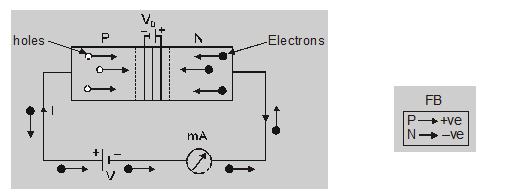
Special Point:
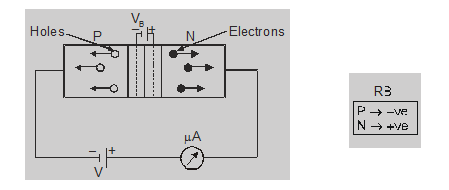
Special Point:
So, that's all from this article. I hope you get the idea about what is P-N junction. If you enjoyed this article then please leave your thoughts in the comments section down below.
Also, read
What is Fermi energy level in semiconductors
To watch Free Learning Videos on physics by Saransh Gupta sir Install the eSaral App.
P-N Junction
- By merely Joining the two pieces a P-N Junction cannot be formed.
- P-N junctions are formed by diffusing trivalent impurity to one-half side and pentavalent impurity to another side.
- The plane dividing the two zones is known as a junction.
- P-N junction is unohmic
- As P-type semiconductor has a high concentration of holes and N-type semiconductor has a high concentration of free electrons. there is a tendency of holes to diffuse over to the N side and electron to the P side.
- When the hole diffuses from the P to N side then this will neutralize with free-electron similarly when electron diffuse from the N to P side it will neutralize with the hole. So, a depletion layer is formed near the Jn.
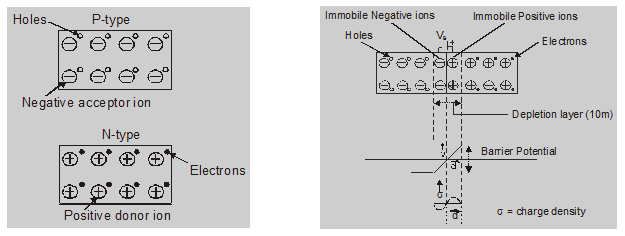
Depletion layer:
There is a barrier near a junction that opposes the flow of charge carrier is known as depletion layer width of the depletion layer is in micrometer order.Potential Barrier:
Potential developed in depletion layer is called P.B.P-side is at lower potential and N-side is at higher potential.
P.B. for Ge 0.3 volt
P.B. for Si 0.7 volt
Electric field:
Electric field due to P.B.
$E=\frac{V}{d}$
For Ge
$E=\frac{0.3}{10^{-6}}$
$=3 \times 10^{5} \mathrm{~V} / \mathrm{m}$
order
$\mathrm{E} \approx 10^{5} \mathrm{~V} / \mathrm{m}$
the direction of E due to P.B. N to P-side
P-N Junction with forward bias :
When the Positive terminal of a battery is connected to the P side and the negative terminal to the N side. Then PN Junction is in forwarding BiasForward bias reduces the potential barrier. More charge carriers diffuse across the junction.

Special Point:
- Potential barrier reduces
- Width of the depletion layer decreases
- P-N junction offers low resistance in forwarding bias.
- Forward current flow in a circuit
- The forward characteristic curve is shown in the figure.
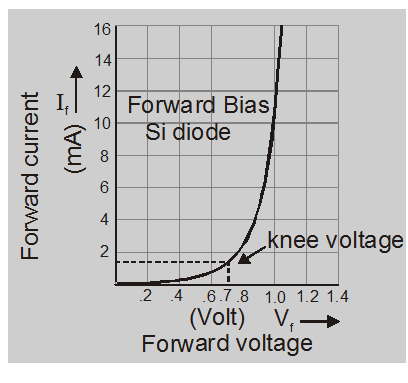
- Forward dynamic resistance $r_{f}=\frac{\Delta V_{f}}{\Delta I_{f}} \cong 100 \Omega$
- Knee or cut in voltageGe 0.3 VSi 0.7 V
- Dependence of forward current on bias voltage $\mathrm{I}=\mathrm{I}_{0}\left[\mathrm{e}^{\frac{\mathrm{qV}}{\mathrm{kT}}}-1\right]$$\mathrm{e}^{\frac{\mathrm{qV}}{\mathrm{kT}}}>>1$
$I \approx I_{0} e^{\frac{+q V}{k T}}$ (Approximate exponential growth)
I = Forward current
$\mathrm{I}_{0}$ = reverse saturation current
k = Boltzman constant
q = charge of electron
V = forward voltage
T = temperature
P-N junction with reverse bias:
When the positive terminal of a battery is connected to the N-side and the negative terminal is connected to the P-side. Holes in the P-region are attracted towards the negative terminal and the electrons in the N-region are attracted towards the positive terminal.
Special Point:
- The depletion layer increases for reverse biased.
- Potential barrier increases
- The reverse characteristic curve is shown in figure
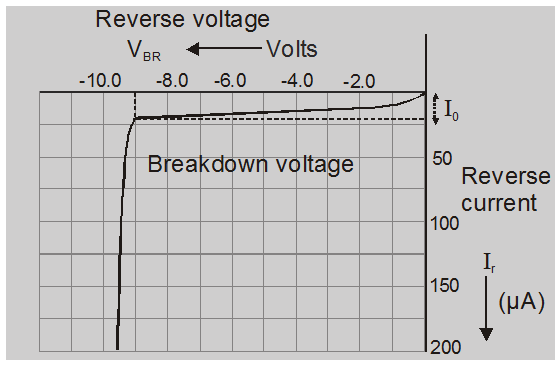
- Very little current called reverse saturation current flows due to minority carrier flow.For Silicon = $10^{-9}$ AFor Germanium = $10^{-6}$ A
- In reverse biased condition, junction behaves as a capacitor of few picofarads.
- In reverse biased condition, junction behaves like high resistive material between two regions.
- In reverse biased P-N diode behaves like an insulator.
- Reverse resistance
$\mathrm{R}_{\mathrm{B}}=\frac{\Delta \mathrm{V}_{\mathrm{B}}}{\Delta \mathrm{I}_{\mathrm{B}}} \cong 10^{6} \Omega$$\frac{R_{B}}{R_{f}}=10^{3}$ : 1 for Geand
$\frac{R_{B}}{R_{f}}=10^{4}$ : 1 for Si - Dependence of reverse current on bias volt.
$\mathrm{I}_{\mathrm{r}}=\mathrm{I}_{0}\left[\mathrm{e}^{-\frac{\mathrm{q} \mathrm{V}}{\mathrm{kT}}}-1\right]$$\mathrm{e}^{-\frac{\mathrm{qV}}{\mathrm{kT}}}<<1$$\mathrm{I} \cong-\mathrm{I}_{0}$
Here $\mathrm{I}_{\mathrm{r}}$ = reverse current
$\mathrm{I}_{0}$ = reverse saturation current
V = applied voltage
q = charge of electron
T = temperature in kelvin
- The diffusion current in the p-n junction is greater than the drift current in magnitude if the junction is forward biased.
- A hole diffuses from the p-side to the n-side in a p-n junction. This means that a bond is broken on the n-side and the electron freed from the bond jumps to a broken bond on the p-side to complete it.
So, that's all from this article. I hope you get the idea about what is P-N junction. If you enjoyed this article then please leave your thoughts in the comments section down below.
Also, read
What is Fermi energy level in semiconductors
To watch Free Learning Videos on physics by Saransh Gupta sir Install the eSaral App.
